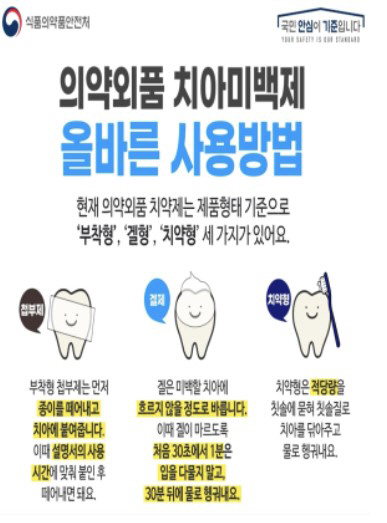Don't swallow tooth bleach...The elderly and the weak should be careful of using ethanol-containing softener
On the occasion of 'Oral Health Day', the Ministry of Food and Drug Safety has released a guide on the correct selection and use of tooth whitening, oral refresher, and toothpaste, which are non-medical drugs often used in the oral cavity.
|
After applying the gel to the teeth, do not shut up and wait for the gel to dry for a set amount of time for each productAfter 30 minutes, rinse with water. The adhesive is removed and attached to the tooth by removing the peeling agent (film attached to the tooth attachment surface) and then removing it according to the usage time of the product manual. The paste agent is applied to a toothbrush in an appropriate amount to clean the tooth with brushing and rinse it with water.
Do not swallow dental bleach, and consult a doctor, dentist, or pharmacist if you have eaten the product. In addition, temporary gum irritation or chilling symptoms may occur when using dental whitening agents, so if symptoms persist, it should be stopped, and orthodontics patients, patients with intraoral infections or wounds, pregnant women and lactating women are not recommended. In particular, products containing 'hydrogen peroxide' should be used after consultation with dentists for children under 12 years of age, and products containing 'carbamide peroxide' should not be used for children under 14 years of age, pregnant women, and lactating women.
Second, the oral liquid preparation is a product that can easily rinse the mouth to obtain effects such as removing bad breath and washing the mouth, and is called gargle liquid and oral cleansing liquid.
Keep 10~15mL in your mouth once or twice a day, gargle for about 30 seconds, and make sure to spit it out. Rinse what is left in the mouth with water as needed and do not consume food for about 30 minutes after use. It is recommended not to use some oral refresher containing ethanol in people with dry mouth or elderly people who may easily dry their mouths. If hypersensitivity reactions such as rash, fever, or fever occur in the mouth during use, or if you have a high fever, headache, or nausea, you should consult with a doctor, dentist, or pharmacist.
Finally, toothpaste is a product used to clean the mouth and prevent tooth, gum, and oral diseases. It is important to check the condition of an individual's teeth and the active ingredients listed in the product and to choose a toothpaste that suits you, as the efficacy and effects of each product may vary depending on the active ingredient (main ingredient).
To prevent gingivitis or periodontitis, it is recommended to use toothpaste containing sodium chloride, tocopherol acetate, pyridoxine hydrochloride, and allantoin. For teeth with plaque or tartar, it is recommended to use toothpaste containing silicon dioxide, calcium carbonate, and calcium hydrogen phosphate, which have the effect of removing plaque, or toothpaste containing sodium pyrophosphate to prevent tartar deposition.
In addition, there are various types of products such as paste, gel, acid, tablet, and liquid, and be careful not to swallow toothpaste when using it, and after using it, the mouth should be thoroughly rinsed with water. In particular, refined toothpaste chews one or two tablets within three times a day and then brushes your teeth with a toothbrush or puts it on a toothbrush to brush your teeth. Keep an appropriate amount of liquid toothpaste in your mouth, gargle it for about 30 seconds, spit it out, and brush your teeth with a toothbrush.
Toothpaste bleach, heavy liquid, and toothpaste have different methods of use depending on the type of product, so be sure to check the container, packaging, or usage, capacity, and precautions stated in the attached document before using them properly. In addition, when purchasing products online, it is important not to be misled by false or exaggerated advertisements about efficacy and effectiveness and to check whether the product is licensed (reported) to the Ministry of Food and Drug Safety.
Meanwhile, the Ministry of Food and Drug Safety examined online unfair advertisements on non-drug products last year and found a total of 362 cases (27 cases of tooth whitening, 157 cases of toothpaste, and 178 cases of oral cleaning products) that advertised toothpaste and oral cleaning products as 'gum regeneration' and 'anti-inflammatory function' beyond the approved efficacy and effect of quasi-drugs and requested the Korea Communications Standards Commission to block access to the post.
This article was translated by Naver AI translator.




